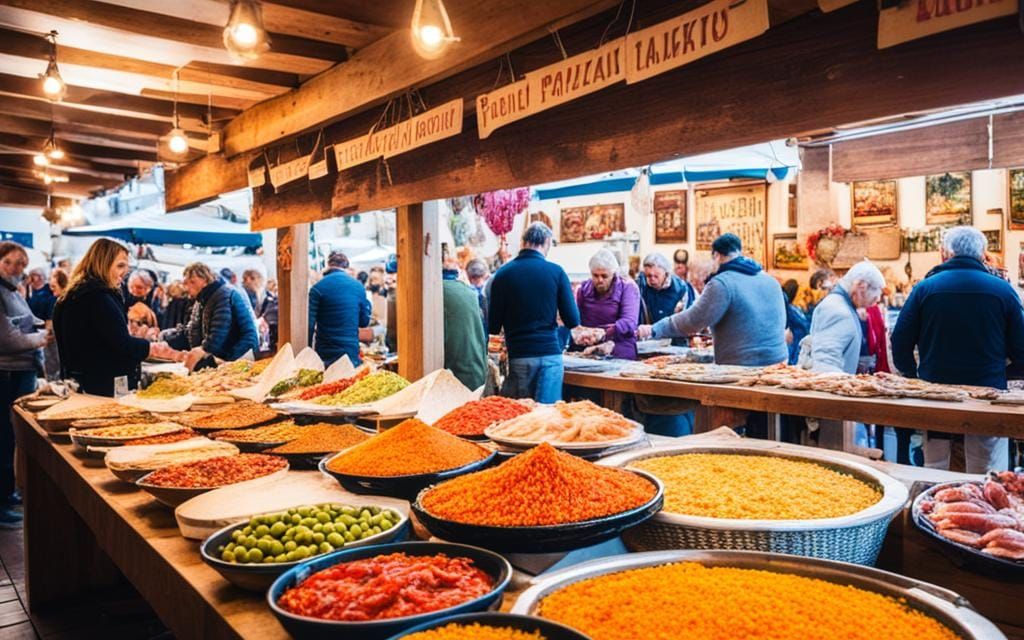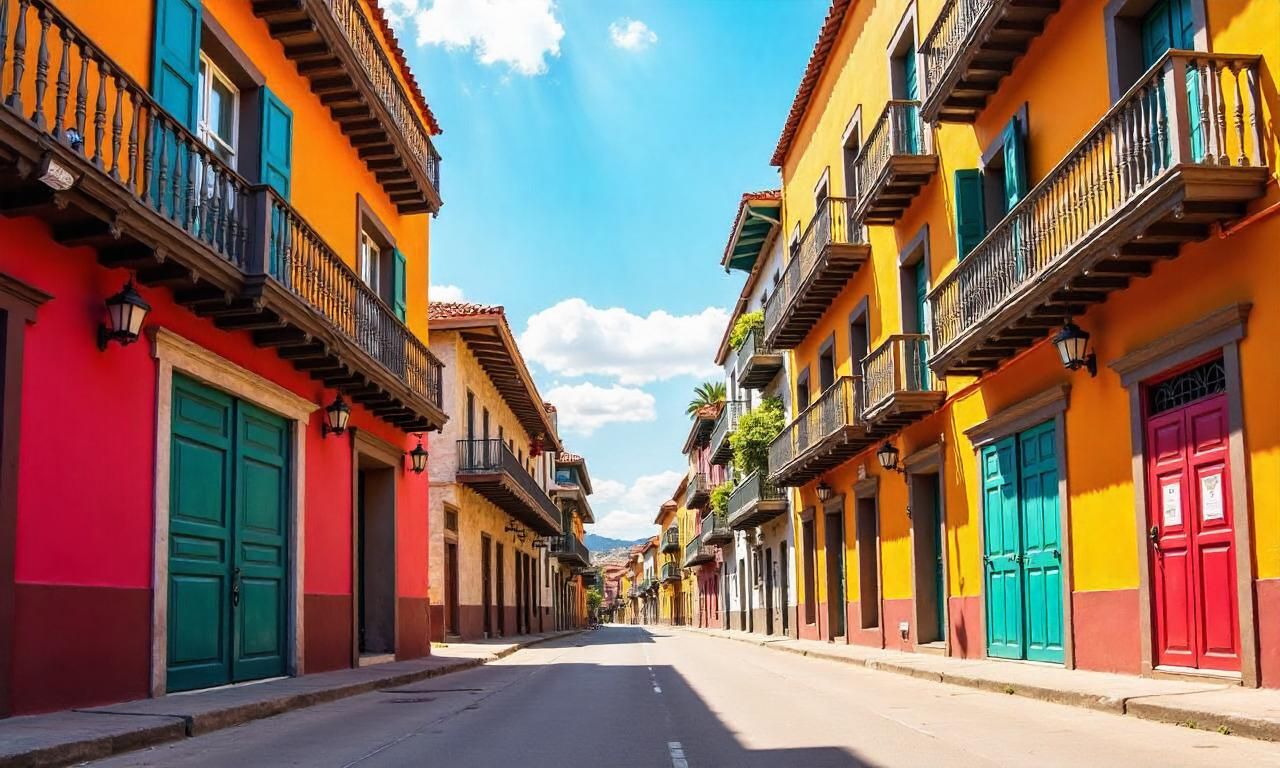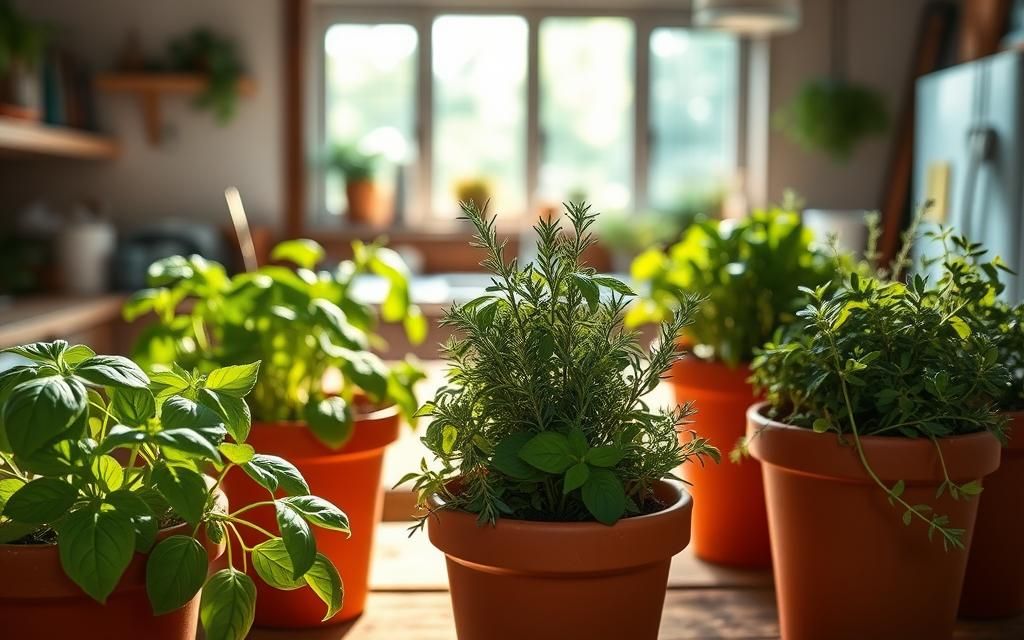Food and Culture of Spain – Spain’s culinary heritage is rich and diverse, capturing hearts worldwide. It’s known for olive oil’s liquid gold and famed Iberico ham. Spanish cuisine celebrates fresh, local ingredients and centuries-old traditions. Dishes like the famed paella and tortilla de patatas reflect Spain’s creative chefs with pride.
The tapas culture lets people share small bites, reflecting a beloved way of life. We’ll look into the Mediterranean diet’s impact on Spanish flavors. Also, how history and culture from the Moorish legacy to Spain’s Golden Age have influenced its gastronomy. Let’s enjoy exploring Spain’s top culinary destination.
Table of Contents
ToggleThe Essence of Spanish Cuisine
Spanish cuisine is captivating because it honors local ingredients. Olive oil, known as the “liquid gold” of Spain, enriches many dishes. It’s the world’s largest olive oil producer, showing a deep love for the olive’s health benefits and flavor.
Olive Oil – The Liquid Gold
Olive oil does more than cook in Spanish meals; it’s a key flavor element. It adds complexity to various foods, from seafood to stews. Its unique taste symbolizes Spain’s rich food culture.
Iberico Ham – A Spanish Delicacy
Iberico ham, a true Spanish gem, comes from pigs that roam free and eat acorns. This special care creates a distinctive taste. It stands as a symbol of Spain’s culinary mastery.
Fresh Ingredients and Seasonings
Spanish cooking focuses on top-quality, fresh ingredients like fruits, veggies, and meats. Cheeses and special seasonings like paprika and saffron are key. They add a unique taste that reflects Spain’s culinary heritage.
Regional Specialties and Beloved Dishes
Spain’s food scene represents a mix of regional favorites, each showing its own culinary history. For example, paella comes from Valencia and is known all over. This rice dish mixes well with seafood, meat, or both. On the other hand, the tortilla de patatas, a Spanish omelette, is a must-try. It’s simple and tasty, and you’ll find it all over Spain.
Paella – The Pride of Valencia
Paella is a top dish from Valencia that Spaniards are very proud of. It comes in many forms, like with seafood or chicken. It’s flavored with saffron, known for its unique taste and yellow color. Making the perfect paella takes a lot of skill and knowledge, especially in cooking the rice just right.
Tortilla de Patatas – The National Tapa
The Spanish omelette, or tortilla de patatas, is a favorite finger food in Spain. It’s a mix of eggs, potatoes, and onions. Found all over Spain, it can be enjoyed alone or part of a meal. The dish’s simplicity doesn’t take away from its popularity for both locals and tourists.
Cocido and Fabada – Hearty Casseroles
Besides paella, Spain is famous for its filling casserole dishes. Cocido is one example. It’s a stew with meats, veggies, and chickpeas slowly cooked together. Fabada, on the other hand, focuses on beans, pork, and chorizo. These dishes show Spain’s passion for flavorful, slow-cooked meals.
Roast Meats and Seafood Delights
Spain shines in cooking roast meats and seafood too. Cochinillo and lamb are delicacies here, cooked to perfection. Seafood lovers enjoy dishes like fried pescaíto and octopus a la gallega. These meals reflect the rich taste and various cooking styles of Spanish food.
The Tapas Culture
The tapas culture is a big part of life in Spain. It’s where small dishes are served with drinks. You might get anything from olives to fancy dishes. People love going from bar to bar to try different tapas. This is called a “tapas crawl” and it’s a fun way to spend time with friends.
Tapas can be hot, cold, savory, or sweet. There’s a lot of variety, depending on where you go. Trying tapas is more than just eating. It’s about being with others and enjoying local food scenes.
Tapas Traditions and Varieties
Spain has a long history with tapas. Every place has its own special kind. You might see the classic tortilla de patatas or the more unique pulpo a la gallega.
Tapas Crawl – A Spanish Ritual
Bar hopping in Spain is a must-do activity. People love going from bar to bar. They try different tapas and enjoy the lively atmosphere. It’s a fun way for both locals and tourists to experience Spain.
Food and Culture of Spain
Spain’s food and culture go hand in hand. It’s known for the Mediterranean diet. This diet is full of olive oil, fresh veggies, and local ingredients. The Mediterranean diet keeps people healthy and encourages eating together.
Mediterranean Diet and Healthy Eating
The Mediterranean diet is famous for being good for you. It focuses on fruits, vegetables, and olive oil. It also encourages eating whole grains and not too much meat. This way of eating is shown to be healthy.
Meals as Social Occasions
Spain is all about sharing food and enjoying meals together. This isn’t just about eating. It’s how people come together with family and friends. It’s a big part of Spanish culture to enjoy food and each other’s company at meal times.
Spanish Chefs and Culinary Excellence
Spain is known worldwide for its top chefs and delicious food. Currently, there are 272 Michelin-starred restaurants in the country. This shows how creative and skilled Spanish chefs are.
Michelin-Starred Restaurants
Many Spanish chefs are on the list of the “World’s 50 Best Restaurants.” Dabiz Muñoz has been named the top chef three times at “The Best Chef Awards.” This success makes Spain a key player in global cuisine.
World’s Best Chefs and Sommeliers
Spain doesn’t just have great chefs – it’s also home to leading sommeliers. Josep Roca, from Celler de Can Roca, was even named the best sommelier in the world. The country’s talented chefs and wine experts make Spain perfect for anyone who loves food and wine.

The Flavors of Spain’s Wine
Spain is famous for its delicious food and rich wines. It has many wine regions, each known for special tastes. You can find everything from bold reds in Rioja to refreshing whites in Galicia.
Wine Regions and Varietals
Spain is very proud of its wine culture. You’ll discover amazing wines in places like Rioja, Ribera del Duero, and Rías Baixas. Each area offers a different kind of joy, from red grape Tempranillo to the white Albariño.
Learning about these wines is like taking a trip through Spain’s history. It’s a way to appreciate the country’s love for making great wines.
Wine Tourism and Tastings
Visiting Spain for wine is a popular thing to do. Many places welcome you to see their vineyards and taste their wines. You can also enjoy wine events and learn how wines are made.
Whether you’re enjoying a classic like Tempranillo or trying something new, Spanish wines are a great part of its culture. They enhance the country’s already fantastic food.
Seasonal Delights and Holiday Traditions
Spain’s food changes with the seasons and special times of the year. In the hot summer, you’ll find people enjoying cool soups like gazpacho. It’s made with fresh tomatoes and veggies. This shows the country’s love for using local, fresh foods.
Spain also ties foods to big holidays like Christmas and Easter. These times bring out special dishes that families have enjoyed for years. This connection between food and traditions really shines during these seasons. Whether it’s the refreshing gazpacho in the summer or special holiday meals, food is a big part of Spain’s culture.
Summer Refreshments: Gazpacho and Salmorejo
Summer means enjoying special cold soups in Spain. Gazpacho is a favorite, blending ripe tomatoes and seasonings. It’s from the southern region of Andalusia. Another option is salmorejo. This soup is thicker and creamier. It’s made with tomatoes, bread, and olive oil. It’s often topped with hard-boiled eggs and Iberico ham pieces.
Christmas and Easter Culinary Specialties
Christmas and Easter are big food celebrations in Spain. At Christmas, people eat roasted suckling pig with veggies and potatoes. For Easter, lamb dishes like cordero asado are popular. There’s also the savory empanada gallega pie. These meals are more than just food. They connect families to old traditions and Spain’s rich culture.
The Influence of History and Culture
Spain’s cuisine is a mix of history and diverse cultures. For example, the Moorish ruled Spain for about 800 years. This rule influenced Spanish cooking, introducing saffron and almonds. These flavors and cooking styles blended with local dishes well.
Moorish Influences
The Moors from North Africa had a big impact on Spain’s food. They introduced saffron and almonds. These new ingredients made Spanish dishes richer and more flavorful. The Moors also taught locals to cook in clay pots. This method is still used for making delicious stews and braises.
The Spanish Golden Age
Spain’s Golden Age was a time of great art and culture. It was also important for the country’s food. Spain’s theater and arts became famous around the world. At the same time, its culinary traditions were getting better known too. The mix of Spain’s history, culture, and cuisine shapes their unique food heritage.
The Art of Spanish Dining
In Spain, dining is more than just eating. It’s about gathering and enjoying each other’s company. Meals are enjoyed in several courses. This typically includes aperitivos, first and main courses, and ends with dessert and coffee. This slow approach to eating makes room for good talks and the enjoyment of every bite.
Traditional Meal Structure
Spain’s meal traditions show their love for food. The meal starts with aperitivos to get everyone’s appetite going. Next comes the primer plato, a light salad, a soup, or a pasta. The main course, or segundo plato, is a showstopper, featuring local favorites like paella or a roast.
To finish off, there’s dessert and coffee. This slow, course-by-course way of eating lets people truly appreciate the food. Meals can last a long time, filled with joy and chats.
Etiquette and Customs
The way Spaniards dine shows their strong social bonds. They share food and often go on a “tapas crawl.” This involves moving from place to place to try different tapas. This sharing and exploring brings people together.
Spanish dining customs are a key part of their culture, where eating is more than meals. It’s a time for family and friends to create lasting memories.
Conclusion
Spain’s food is closely tied to its culture, forming a rich tapestry of traditions and innovative cooking. The country is famous for using high-quality ingredients, like olive oil and Iberico ham. It celebrates a lively tapas culture and hearty regional dishes.
Mealtimes in Spain are moments to come together, reflecting the central role of food in community life. This culture shows the country’s history and the pride people take in their food. By exploring Spain’s cuisine, you can connect with its rich cultural offerings.
Spain’s food has won worldwide praise for its distinct and memorable dishes. Whether it’s the lively tapas culture or the diverse regional foods, Spain’s cuisine showcases its culinary depth. Discovering Spain’s food is a journey through its celebrated traditions and innovative cooking styles.
FAQ
What are the key ingredients and signature dishes that define Spanish cuisine?
The heart of Spanish cooking lies in using fresh, top-quality foods. Olive oil, Iberico ham, lots of fruits and veggies, seafood, and artisan cheeses are key. Dishes like paella, Spanish omelette, and hearty stews are famous. So are roast meats and tasty seafood.
What is the tapas culture in Spain, and how does it contribute to the country’s culinary experience?
Tapas are a big part of life in Spain. They are small plates of food with drinks. These can be simple or complex. The tradition of ‘tapas crawl’ means trying food at many bars.
Tapas are about food and friends. They’re a way to socialize and explore local flavors.
How is the Mediterranean diet reflected in the food and culture of Spain?
Spain leads in the Mediterranean diet with its use of olive oil and fresh veggies. This diet is not just healthy. It’s about enjoying food together. Sharing tapas and having leisurely meals are part of Spain’s rich culture.
What is the current status of Spain’s culinary excellence on the global stage?
Spain is known worldwide for its chefs and food. It has 272 Michelin-starred restaurants. Many Spanish chefs make the “World’s 50 Best Restaurants” list.
Spain also excels in wine. This shows its strong position in the culinary world. Here’s more about Spain’s culinary scene.
How do the seasons and cultural traditions influence the cuisine of Spain?
Spain’s food changes with the seasons. Cool dishes like gazpacho are loved in summer. Cultural traditions show in holiday meals. These include unique foods for Christmas and Easter.
Food is deeply tied to Spain’s culture and identity. It shows in their celebrations and everyday meals.
What are the historical and cultural influences that have shaped the food and dining experiences in Spain?
The history and cultures of Spain have deeply influenced its food. For example, the Moorish period brought saffron and almonds. The Golden Age also affected Spanish cuisine.
History, culture, and food mix to create Spain’s diverse culinary heritage. Each period brought something new to the table.















